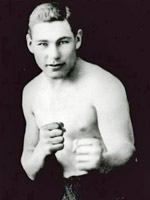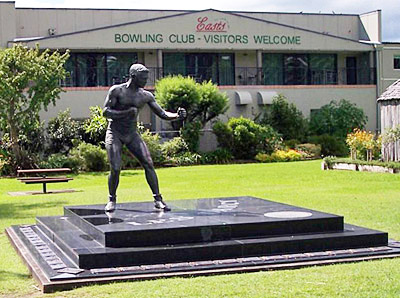

| Les's family details are available in my family files. |

This article by W.G. Mcminn was published in the Australian Dictionary of Biography, Volume 8, 1981
James Leslie (Les) Darcy (1895-1917), boxer and folk hero, was born on 31 October 1895 at Stradbroke, near Maitland, New South Wales, second son of native-born parents Edward Darcy (or Dorsey), labourer and later a share-farmer, and his wife Margaret, née O'Rourke. His grandparents came from Tipperary, Ireland. Leaving Oakhampton Public School in 1907 Les worked as a carter before being apprenticed at 15 to a blacksmith at East Maitland. As his father was at times unemployed, and his elder brother was partly crippled, Les was called upon to help his large family.
Darcy made his first money in the boxing ring at 14. In 1912-13 he won several fights at Newcastle and Maitland. In November 1913 he lost to the Australian welter-weight champion Whitelaw, but his performance attracted the attention of the Sydney promoters. On 18 July 1914 he appeared for the first time at the Sydney Stadium, against the American Fritz Holland. Darcy was already a local hero—his supporters came from Maitland in two special trains. When Holland won on points there was a riot; two months later Darcy lost on a foul to Holland and 'the cognoscenti' were ready with elaborate accounts of how Holland had contrived the incident. They need not have worried: Darcy had impressed the promoter R. L. (Snowy) Baker. He became the stadium's leading drawcard. In January 1915 he fought the American Jeff Smith in a contest billed as a world welter-weight championship. When he lost because his seconds refused to let him continue after being hurt by a foul blow that the referee did not see, the sensation only enhanced his fame. That defeat was his last: until September 1916 he won twenty-two consecutive fights. He was now comparatively well off—when he bought himself out of his indentures in mid-1915 each contest was netting him about £300, and he was also being paid for exhibitions and for acting in a film.
At the end of 1915 Darcy announced his intention to accept an offer of fights in the United States of America but, probably influenced by Baker, he changed his mind. Six months later the political atmosphere had been radically altered by the Easter week rising in Dublin and W. M. Hughes's commitment to conscription; and passports were being refused to men of military age. Darcy began to come under pressure to enlist—partly at least as an example to other young men—and his predicament was aggravated by his Irish-Catholic background. His own attitude was ambivalent, but he was now anxious to go to America. He claimed that he wanted four or five fights there to make his family financially secure, and then he would go to Canada or England to enlist. His decision may have been influenced by E. T. O'Sullivan, an ingratiating adventurer who had made a big impression on the naive boxer. He and O'Sullivan sailed clandestinely from Newcastle on 27 October, the day before the referendum which, had it been carried, would have made him liable to conscription. The patriotic press denounced him as a shirker; so too, with less disinterested motives, did Baker and his connexions.
In New York a major fight was arranged, but it was banned by Governor Whitman, ostensibly because of the manner in which Darcy had left Australia. The decision was disastrous for Darcy: promoters began to lose interest in him. He broke with O'Sullivan, gave some vaudeville exhibitions and on 5 April 1917 took out United States citizenship. A fortnight later, after a bout he had arranged in Louisiana was also banned, he volunteered for the army. Yet another fight was arranged in Memphis, Tennessee, and Darcy's call-up was deferred so that he could train, but on 27 April he collapsed. He was admitted to hospital with septicaemia and endocarditis; his tonsils were removed but he developed pneumonia and died on 24 May; his fiancée Winnie O'Sullivan was at his deathbed. His body was brought back to Australia and, after immense funeral processions in San Francisco and Sydney, was buried in the Catholic section of East Maitland cemetery.

Les Darcy had all the makings of a folk hero. His remarkable ring record—he lost only four professional fights and was never knocked out—was associated with a quite extraordinary physique: a muscular body apparently impervious to the heaviest blows and a reach 7 ins (18 cm) greater than his height of 5 ft 7 ins (170 cm). He neither smoked nor drank, and spent most of his income on his family; he attended Mass most mornings, one of his closest friends being the local priest. His decision to leave Australia secretly, in breach of the War Precautions Act, provided the controversy (and the enemies in high places) without which no hero-figure is complete: his lonely death gave him an aura of martyrdom.
So powerful a legend did he become that fifty years after his death flags flew at half-mast, and a memorial at his birthplace was unveiled by Sir William McKell, former governor-general. When he had been dead for two generations, he was still inspiring the pens of Australian nationalist writers.
OUR LINK: Les' brother John M. Darcy married Marjorie Osborn. Marjorie's sister Hazel J. Osborn married Harry G. Fairhall

| Les' family details are available in my family files. |
